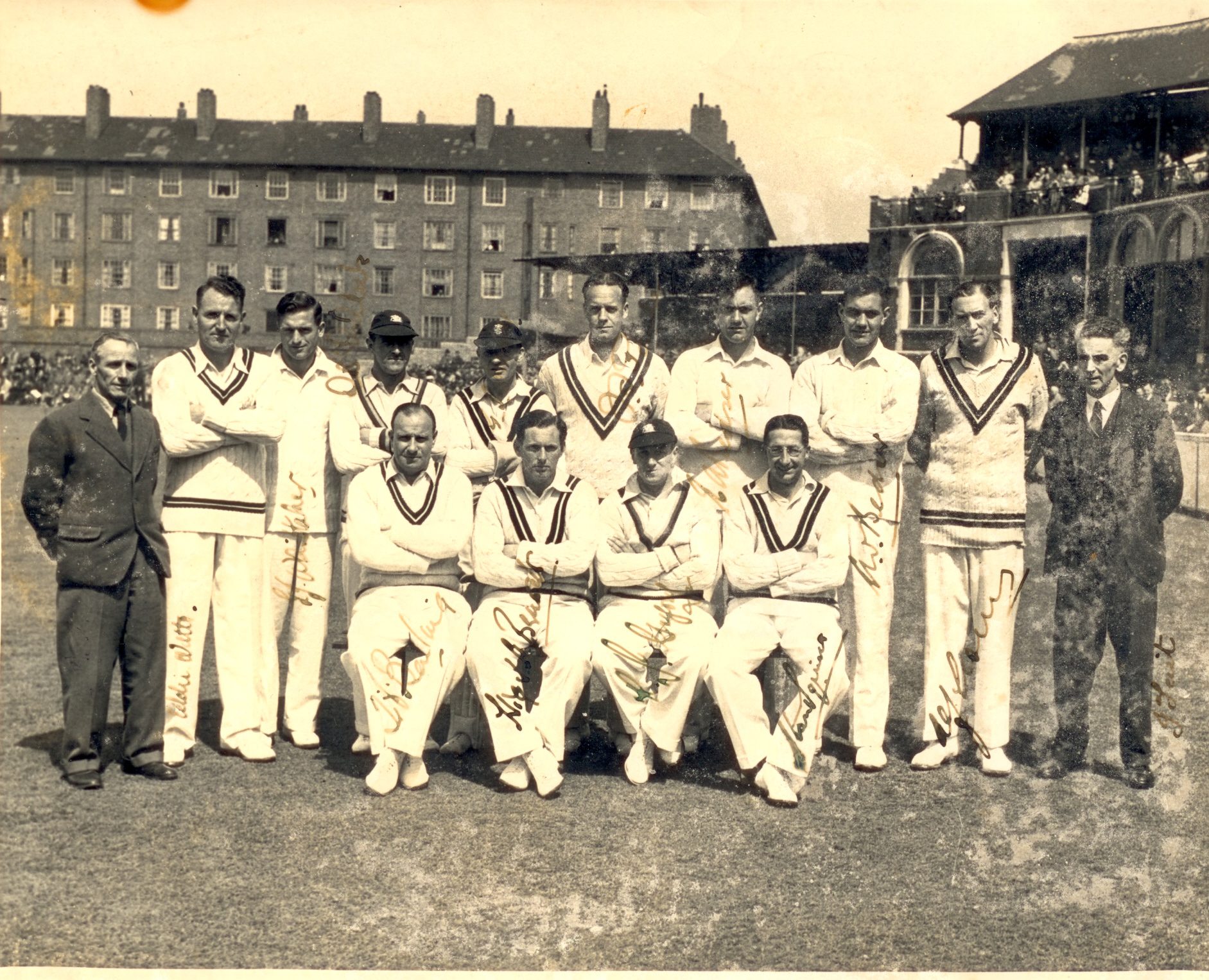Celebrating a major landmark when there is a world emergency in progress sounds horribly familiar now.
Surrey’s 175th anniversary season was in danger of being a complete write-off at one stage as the Covid-19 crisis took precedence.
It’s an echo of the club’s centenary in 1945, as the Second World War drew to a close, but the conflict meant that no first-class cricket had been played since September 1939.
But for the generosity of many members who continued to pay their subscriptions, despite knowing there was no prospect of any cricket for the time being, Surrey might not have survived.
Victory over Germany – VE Day – was celebrated on May 8 but the Second World War rumbled on for three more months until two atomic bombs dropped on Japan prompted the end of hostilities and brought VJ Day on August 15.
While some wartime cricket was played – Lord’s staged games and there were club matches – The Oval had been requisitioned shortly after the war started, initially being used to house anti-aircraft spotlights and then transformed into a prisoner-of-war camp.
Although no prisoners were to be housed, the damage which was done to the ground was immense while the pavilion and stands suffered bomb scars, mainly superficial.
Legendary groundsman ‘Bosser’ Martin had retired during the war and his successor Bert Lock wasted no time upon being demobbed in 1945. He faced a massive task to restore the ground, some estimating that it could take up to three years before cricket could be played.
Although materials were scarce, labour was plentiful so Lock engaged work parties to clear the playing area. That was an awesome task in itself, nearly 1,000 concrete piles two feet deep and huge bases for the huts which would have housed POWs – plus miles of barbed wire – needing to be removed.
Lock knew where he could find a new outfield as well, scouring Gravesend Marshes to find the turf he wanted, and having to remove many weeds from the square before he could make the square playable again.
A fund was set up to help repair the damage and the government paid compensation for the wear and tear inflicted by the long occupancy of the military.
The closest a German came to the ground appears to have been on September 15 1940, the day when the Battle of Britain came to a climax.
According to local historians, a Dornier was brought down and its pilot, Feldwebel Robert Zehbe, landed outside Alverstone House in Harleyford Road. His parachute became snagged on a telegraph pole but whether Zehbe’s injuries were sustained from the descent or a vengeful group which greeted him is unclear. Zehbe had to be rescued by the Police and was taken to the Millbank Military Hospital, where he died the next day.
Although the RAF had avoided destruction, they could not stop the blitz on London – and other cities – which a month later, on October 15, included a bomb killing 104 people on the nearby Kennington Park Estate.
A longer-term reminder of war was apparent in the neighbourhood until recent years, thousands of old ARP stretchers having been converted into railings on local roads around Kennington and Vauxhall.
On the field
Although the decision had already been to celebrate the centenary a year late in 1946, Surrey managed to play three matches in 1945, albeit not first-class.
Hostilities had come to a complete halt when, on August 25, Surrey returned to action almost six years after war had stopped play when they hosted Sussex in a one-day friendly at Malden Wanderers’ ground in New Malden.
The visitors were dismissed for a meagre 76 – Fred Pierpoint, who played eight first-class matches between 1936-46, claiming 4-23 – and Surrey batted on after winning to reach 149-6 of which Brian Wix hit 60no. The side was led by Monty Garland-Wells, who had been captain in 1939, and included Jack Parker – selected for England’s tour of 1939-40, which was never to take place – Stan Squires, George Mobey and Bernie Constable.
Oddly, the Sussex side featured Stuart Surridge – presumably to make up the numbers given matches were often arranged at short notice – the man who would lead Surrey to five straight County Championship titles in 1952-56 before they went on to make it seven under Peter May.
Fresh from that cobweb-shifting exercise, they entertained the Australian Services XI which was attracting large crowds as the British public enjoyed peacetime at least, featuring the likes of skipper Lindsay Hassett, Cec Pepper and Keith Miller, who had until recently been a pilot with the Royal Australian Airforce.
This time the Leyland Motors Ground in Kingston became Surrey’s temporary home and their side was strengthened by the return ofTest players Laurie Fishlock, Freddie Brown and Alf Gover, plus pre-war favourite Tom Barling.
Rain restricted the first day, the tourists finishing 40-2 but on the second they were rolled for 90, skipper Hassett top-scoring with 20, as Gover and Pierpoint claimed three wickets each and leg-spinner Brown returned 4-17.
That was no mean feat for a man who had had been captured by the Germans at Tobruk in 1942 and spent the rest of the conflict as a prisoner-of-war.
Miller immediately underlined the threat which made him one of the great fast bowlers of his time by bowling Fishlock and Squires but Barling, just a few days after his 39th birthday, made 51 out of 113 all out.
The Australians fared even worse second time round, Bob Cristofani’s 36 their only score in double-figures out of 73, Gover taking another three, Brown four more and Parker two.
Not that Surrey had it easy chasing their modest target, needing 23 from Squires to limp over the line by three wickets.
Their final outing came at Hastings in a one-day engagement with Northamptonshire. Fishlock’s 53 was the high point of reaching 145-8dec in 52 overs, Dennis Brookes’s 58 guiding Northants to a five-wicket success despite speedster Eddie Watts marking his return with 2-53.
The cricket, of variable standard, mattered little in itself but it had given senior players a chance to find their bearings, youngsters an opportunity to show what they might achieve in the future and everyone a welcome dose of what might now be termed the “new normal”.
What else happened in 1945?
Bringing the war to a close and beginning the recovery dominated life in Britain.
The first post-war election – held in July, before Japan had been beaten – saw one of the great surprises in history when Winston Churchill’s Conservative Party were thrown out by the Labour Party, who claimed a majority of 146 seats under the leadership of Clement Attlee.
The BBC General Forces Programme was replaced by the Light Programme, focusing on music and entertainment.
George Orwell’s novel Animal Farm was published, as were Evelyn Waugh’s Brideshead Revisited and the Rev WV Awdrey’s The Three Railway Engines, which included a tank engine called Thomas.
Piccadilly Circus became the first London Underground station to be illuminated by fluorescent lighting.
Britain signed the charter of the newly-formed United Nations.
It was hankies out at the cinema for Noel Coward’s Brief Encounter, starring Celia Johnson and Trevor Howard.
With the country effectively bankrupt after so long at war, Britain received a loan worth $3.75billion from the United States, which would become available in the new year. Negotiated by economist John Maynard Keynes, it was originally for 50 years but was finally paid off in 2006.
On New Year’s Eve, Britain received its first post-war shipment of bananas.










